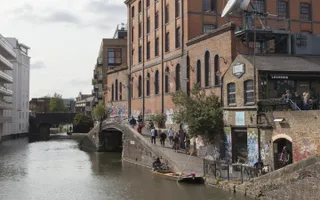An important landmark
Built in 1846, the historic bridge known locally as ‘Dead Dog bridge', is an important local landmark carrying the Regent's Canal towpath across the canal basin beneath the Camden Interchange Warehouse (‘Dead Dog Tunnel'), and is the busiest canal footbridge in the country with over one million walking and cycling visits per year.
The bridge repairs have been enabled by an award from Postcode Earth Trust thanks to funds raised by players of People's Postcode Lottery. The work, which began in mid-January, has included: repairs to the bridge's wrought iron lattice parapets; cleaning of the underlying cast iron beams; and cleaning and repointing the abutments and approach parapets.
Protecting and preserving London Canals
Ros Daniels, our director for London & South East, explains: “Research shows that being next to water improves your mental and physical health. The Canal & River Trust protects and preserves London's canals, making them welcoming to encourage more people to enjoy the health and wellbeing benefits of walking and cycling, and being by the water.
“The Interchange Basin Towpath Bridge, known locally as ‘Dead Dog' bridge is a key route for people using the canal through Camden and with over one million visits each year, is one of the busiest bridges on our network. Now over 175 years old, thanks to the players of People's Postcode Lottery and with consent for the London Borough of Camden's conservation team, our engineers have worked with specialist contractors to carefully repair, clean and repaint the bridge's historic parapets and repoint the abutments. The works will ensure this historic bridge continues to carry millions of visitors enjoying the Regent's Canal in Camden, for many years to come.”
A brief history lesson
Built at the beginning of the 20th century by the London & North Western Railway (LNWR), the massive Grade II Listed red brick Interchange Warehouse in Camden was designed to bring together canal, rail and road transport in one covered building, with three layers of storage.
Phil Emery, Canal & River Trust regional heritage adviser, explains: “The Canal & River Trust is the third largest custodian of designated heritage assets, with a dedicated team of specialist heritage advisers ensuring that all the works respect heritage conservation best practice.
“In recent years, the bridge's striking ironwork has been painted black and white, but working with a specialist to analyse the paint layers, we discovered the original colour was most likely to have been ‘Indian Red'. The name refers to pigment used to create the paint colour, made from ground haematite ore obtained in Bengal, the historic region divided between modern-day Bangladesh and the Indian state of West Bengal. This paint colour was used by railway companies, including the London & Birmingham Railway Co (L&BR) which originally owned the Interchange canal basin, whose entrance the bridge crosses.”
Important for the community
Laura Chow, head of charities at People's Postcode Lottery, says: “It's fantastic to see the impact that player funding has had on the ‘Dead Dog' bridge'. Not only is the bridge an iconic landmark in Camden, but it's also vitally important to the community who use it daily for walking and cycling, so it's even more important that it is preserved for future generations.”
The entrance to the Interchange Dock became known as ‘Dead Dog Tunnel' because, historically, debris – including dead animals – accumulated here at the end of the 26-mile lock-free stretch of the canal flowing into central London. ‘Dead Dog Tunnel' has featured in a number of films, including the 2015 Bond film Spectre, where it was used as a double for Q's top secret underground workshop.
Today, the Interchange Building is a co-working office space. Using the Interchange Dock, iRecycle transports waste from the Interchange Building by barge to the Powerday recycling centre in West London.





